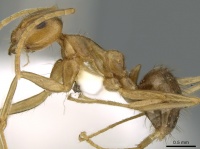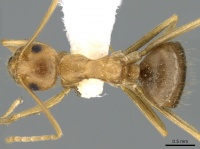Anoplolepis tenella
| Anoplolepis tenella | |
|---|---|

| |
| Scientific classification | |
| Kingdom: | Animalia |
| Phylum: | Arthropoda |
| Class: | Insecta |
| Order: | Hymenoptera |
| Family: | Formicidae |
| Subfamily: | Formicinae |
| Tribe: | Plagiolepidini |
| Genus: | Anoplolepis |
| Species: | A. tenella |
| Binomial name | |
| Anoplolepis tenella (Santschi, 1911) | |
Identification
Distribution
Latitudinal Distribution Pattern
Latitudinal Range: 4.149444444° to 1.010278°.
| North Temperate |
North Subtropical |
Tropical | South Subtropical |
South Temperate |
- Source: AntMaps
Distribution based on Regional Taxon Lists
Afrotropical Region: Cameroon, Congo (type locality).
Distribution based on AntMaps
Distribution based on AntWeb specimens
Check data from AntWeb
Countries Occupied
| Number of countries occupied by this species based on AntWiki Regional Taxon Lists. In general, fewer countries occupied indicates a narrower range, while more countries indicates a more widespread species. |

|
Estimated Abundance
| Relative abundance based on number of AntMaps records per species (this species within the purple bar). Fewer records (to the left) indicates a less abundant/encountered species while more records (to the right) indicates more abundant/encountered species. |

|
Biology
The root feeding Hemipteran Stictococcus Vayssierei is a cassava plant pest that can cause significant damage to this important food crop in some parts of Africa. Anoplolepis tenella tend this scale insect to access the honeydew they produce (Fotso et al. 2008). Ant colonies will establish nests under cassava plants infested with Stictococcus Vayssierei. The ants also transport the scale insects to new plants (Fotoso et al. 2015b). Anoplolepis tenella has also been found tending this same Hemipteran on other plants as well (Fotoso et al. 2015a).
Castes
Nomenclature
The following information is derived from Barry Bolton's Online Catalogue of the Ants of the World.
- tenella. Plagiolepis tenella Santschi, 1911c: 364 (w.) CONGO.
- Type-material: syntype workers (number not stated).
- Type-locality: Congo (“Congo français”): Brazzaville, 1907 (A. Weiss).
- Type-depository: NHMB.
- [Also described as new by Santschi, 1911g: 210.]
- [Plagiolepis tenella Forel, 1909b: 61. Nomen nudum (attributed to Santschi.]
- Wheeler, W.M. 1922a: 214 (q.m.).
- Combination in Plagiolepis (Anoplolepis): Santschi, 1914b: 123;
- combination in Anoplolepis (Anoplolepis): Emery, 1925b: 18.
- Status as species:Wheeler, W.M. 1922a: 214, 934; Emery, 1925b: 18; Bolton, 1995b: 67; Bolton, 2003: 267.
- Distribution: Congo, Democratic Republic of Congo.
Description
References
- Boudinot, B.E., Borowiec, M.L., Prebus, M.M. 2022. Phylogeny, evolution, and classification of the ant genus Lasius, the tribe Lasiini and the subfamily Formicinae (Hymenoptera: Formicidae). Systematic Entomology 47, 113-151 (doi:10.1111/syen.12522).
- Emery, C. 1925d. Hymenoptera. Fam. Formicidae. Subfam. Formicinae. Genera Insectorum 183: 1-302 (page 18, combination in Anoplolepis)
- Fazam, J.C., Shimizu, G.D., Almeida, J.C.de, Pasini, A. 2021. Mortality of leaf-cutting ants with salicylic acid. Semina: Ciências Agrárias 42, 2599–2606 (doi:10.5433/1679-0359.2021v42n4p2599).
- Fotso, A. K., R. Hanna, M. Tindo, A. Doumtsop, and P. Nagel. 2015a. How plants and honeydew-producing hemipterans affect ant species richness and structure in a tropical forest zone. Insectes Sociaux. 62:443-453. doi:10.1007/s00040-015-0423-5
- Fotso, A. K., R. Hanna, M. Tindo, and P. Nagel. 2015b. Transport and Dispersal of Stictococcus Vayssierei (Hemiptera, Stictococcidae) by Anoplolepis Tenella (Hymenoptera, Formicidae). Journal of Insect Behavior. 28:426-435. doi:10.1007/s10905-015-9513-5
- Mbenoun Masse, P.S., Ebolo, G.L.M., Titti, G.E., Mony, R. 2021. Ant species richness, abundance and functional groups along an elevation gradient in Central Cameroon. Biodiversity Journal 12(1): 179-194 (doi:10.31396/biodiv.jour.2021.12.1.179.194).
- Santschi, F. 1911c [1910]. Nouvelle fourmis d'Afrique. Ann. Soc. Entomol. Fr. 79: 351-369 (page 364, worker described)
- Santschi, F. 1911g. Nouvelles fourmis du Congo et du Benguela. Rev. Zool. Afr. (Bruss.) 1: 204-217 (page 210, also described as new)
- Santschi, F. 1914b. Voyage de Ch. Alluaud et R. Jeannel en Afrique Orientale, 1911-1912. Résultats scientifiques. Insectes Hyménoptères. II. Formicidae. Paris: Libr. A. Schulz, pp. 41-148. (page 123, combination in Plagiolepis (Anoplolepis))
- Wheeler, W. M. 1922b. Ants of the American Museum Congo expedition. A contribution to the myrmecology of Africa. II. The ants collected by the American Museum Congo Expedition. Bull. Am. Mus. Nat. Hist. 45: 39-269 (page 214, queen, male described)
References based on Global Ant Biodiversity Informatics
- IZIKO South Africa Museum Collection
- Santschi F. 1911. Nouvelles fourmis du Congo et du Benguela. Revue Zoologique Africaine (Brussels) 1: 204-217.
- Tadu Z., C. Djieto-Lordon, R. Babin, Yede, E. B. Messop-Youbi, and A. Fomena. 2013. Influence of insecticide treatment on ant diversity in tropical agroforestry system: some aspect of the recolonization process. International Journal of Biodiversity and Conservation 5(12): 832-844.
- Wheeler W. M. 1922. Ants of the American Museum Congo expedition. A contribution to the myrmecology of Africa. II. The ants collected by the American Museum Congo Expedition. Bulletin of the American Museum of Natural History 45: 39-269.
- Wheeler W. M. 1922. Ants of the American Museum Congo expedition. A contribution to the myrmecology of Africa. VIII. A synonymic list of the ants of the Ethiopian region. Bulletin of the American Museum of Natural History 45: 711-1004

